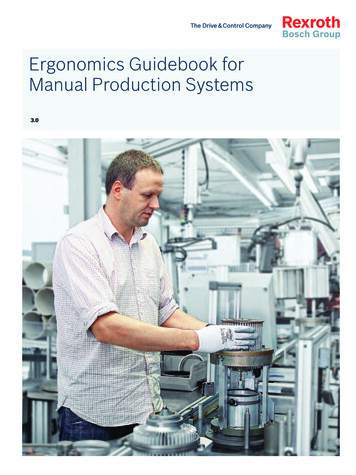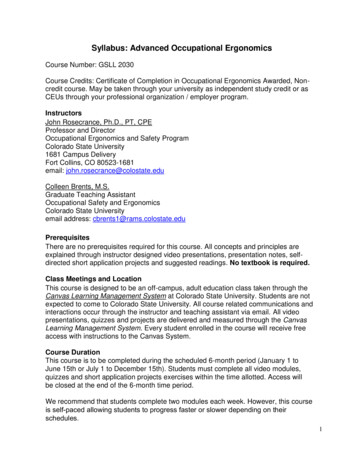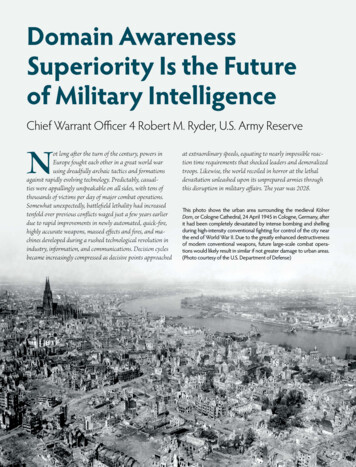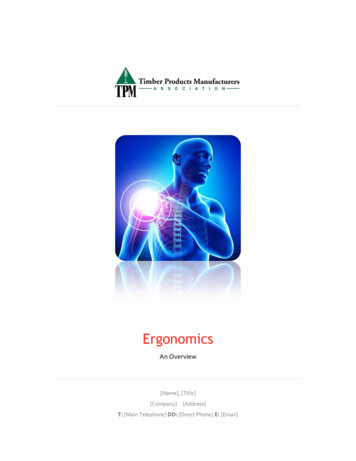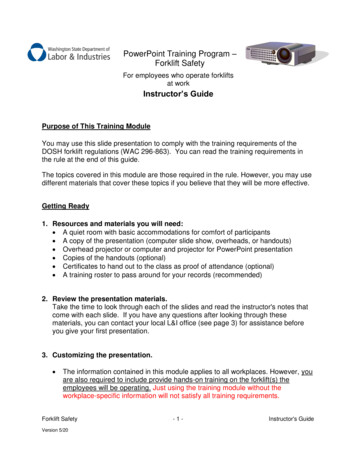
Transcription
PowerPoint Training Program –Forklift SafetyFor employees who operate forkliftsat workInstructor’s GuidePurpose of This Training ModuleYou may use this slide presentation to comply with the training requirements of theDOSH forklift regulations (WAC 296-863). You can read the training requirements inthe rule at the end of this guide.The topics covered in this module are those required in the rule. However, you may usedifferent materials that cover these topics if you believe that they will be more effective.Getting Ready1. Resources and materials you will need: A quiet room with basic accommodations for comfort of participants A copy of the presentation (computer slide show, overheads, or handouts) Overhead projector or computer and projector for PowerPoint presentation Copies of the handouts (optional) Certificates to hand out to the class as proof of attendance (optional) A training roster to pass around for your records (recommended)2. Review the presentation materials.Take the time to look through each of the slides and read the instructor's notes thatcome with each slide. If you have any questions after looking through thesematerials, you can contact your local L&I office (see page 3) for assistance beforeyou give your first presentation.3. Customizing the presentation. The information contained in this module applies to all workplaces. However, youare also required to include provide hands-on training on the forklift(s) theemployees will be operating. Just using the training module without theworkplace-specific information will not satisfy all training requirements.Forklift SafetyVersion 5/20-1-Instructor's Guide
PowerPoint Training Program – Forklift SafetyFor employees who operate forkliftsInstructor’s Guide If you have PowerPoint on your computer, additional information is easily addedto the PowerPoint version after downloading. The PowerPoint version can bemodified, but modification that changes the essential meaning or deletesinformation may not meet the training requirements. If you use the PDF version, the slides cannot be changed, but you can providethe workplace specific information orally, on overhead transparencies or as paperhandouts.4. Prepare the materials and schedule the class If you have a computer video projection system, all you need to do is check tomake sure the presentation works and make copies of the handouts. If you plan to use an overhead projector, print the slides out on transparencies.The PDF version will print quicker and use less printer memory. The slides will beclearer if they are printed in color. If you don't have a color printer, your localprint or copy store can print out color transparencies for you. Schedule the class for a date and time convenient to most people. If you wantmany employees and supervisors to participate, try not to make groups largerthen 15 attendees.Presenting the TrainingGive the presentationYou can use your own words rather than just reading from the script. You can alsomake three-slide-per-page handouts of the training.Ask for participationIt also helps to involve the audience as much as possible by asking them questions andgetting them to talk about their own jobs, their use of forklifts, and any suggestions theymay have on how to operate forklifts safely.Questions and answersAnswer any questions the best that you can. Even if you don't have the technicalknowledge to answer a lot of questions on forklift safety, you can still answer theimportant questions about the way that your company is addressing the potential safetyhazards of operating forklifts. If any questions on forklift safety are asked that you needhelp answering, you can contact the forklift manufacturer or your local L&I office listedon the following page.Forklift SafetyVersion 5/2011-2-Instructor's Guide
PowerPoint Training Program – Forklift SafetyFor employees who operate forkliftsInstructor’s GuideFollow-upWithin a week or two of giving the training, you might want to take a few minutes to talkto some of the employees and supervisors to make sure they understood what waspresented and how it applies to them.Getting helpIf you have questions while preparing to give this presentation, or if questions come upduring the presentation that you need help in answering, contact your local L&I officelisted below for WenatcheeTelephone 60-902-5799509-886-6500E-mail j235@lni.wa.govForklift Training RegulationsWAC 296-863-60005Make sure PIT operators are trainedYou must:Make sure employees successfully complete an operator training program before operating PITs. Theonly time a trainee can operate a PIT is:- Under the direct supervision of a person who has the knowledge, training, and experience to train andevaluate operatorsand- When operating the PIT doesn't endanger the trainee or other employees.Make sure training is done by you, or someone you designate, that has the knowledge, training, andexperience to:- Conduct the trainingand- Evaluate trainee competence.Make sure your operator training program consists of:Forklift SafetyVersion 5/2011-3-Instructor's Guide
PowerPoint Training Program – Forklift SafetyFor employees who operate forkliftsInstructor’s Guide- Formal instruction such as lecture and discussion, interactive computer learning, video tapes,and written material.- Practical training such as demonstrations done by the trainer and practical exercisesperformed by trainees.- Evaluation of trainee performanceMake sure the initial operator training program covers the subjects in Table 4, Required Training Topics.Note:If an operator has previously received training specified in Table 4, Required TrainingTopics, additional training in that topic isn't required if:- The training was appropriate to the PIT and working conditions in your workplaceoand- The employee has passed a PIT performance evaluation within the last 3 years.Table 4Required Training TopicsTopics related to powered industrial truck Topics related to your workplaceSurface conditions where the PIT will be operatedOperating instructionsComposition of loads to be carried and load stabilityWarnings and precautions for the types of PIT theoperator will be authorized to operateDifferences between the PIT and the automobileLoad manipulation, stacking, and unstackingPIT controls and instrumentation: Where they arePedestrian traffic in areas where the PIT will belocated, what they do, and how they workoperatedEngine or motor operationNarrow aisles and other restricted places where thePIT will be operatedSteering and maneuvering Use of door opening and closing devicesVisibility (including restrictions due to loading) Forklift SafetyVersion 5/2011-4-Hazardous (classified) locations where theInstructor's Guide
PowerPoint Training Program – Forklift SafetyFor employees who operate forkliftsInstructor’s GuidePIT will be operatedFork and attachment adaptation, operation, and use Ramps and other sloped surfaces that couldlimitationsaffect the PITs stabilityPIT capacityClosed environments and other areas whereinsufficient ventilation or poor PIT maintenancecould cause a buildup of carbon monoxide or dieselexhaustPIT stabilityOther unique or potentially hazardous environmentalconditions in the workplace that could affect safeoperationAny PIT inspection and maintenance that theoperator will be required to performRefuelingCharging and recharging of batteriesOperating limitationsAny other operating instructions, warnings, orprecautions listed in the operator's manual for thetypes of PIT that the employee is being trained tooperateYou must:Keep written records of operator training and evaluations that include the following information :- Name of the operator- Date of the training- Date of the evaluation- Name of the person giving the training or evaluation.WAC 296-863-60010Forklift SafetyVersion 5/2011-5-Instructor's Guide
PowerPoint Training Program – Forklift SafetyFor employees who operate forkliftsInstructor’s GuideRetrain PIT operators as requiredYou must:Provide PIT operators refresher training if any of the following occur:- The operator is involved in an accident or near-miss incident- The operator is seen operating the PIT in an unsafe manner- An evaluation shows the operator isn't operating the PIT safely- The operator is assigned to drive a different type or modified PIT- Conditions in the workplace change that could affect safe operation of the PIT.Note: Refresher training is required only in those topics where the operator has been founddeficient.Forklift SafetyVersion 5/2011-6-Instructor's Guide
Everett 425-290-1300 dres235@lni.wa.gov Seattle 206-281-5400 solt235@lni.wa.gov Spokane 509-324-2600 poag235@lni.wa.gov Tacoma 253-596-3800 norv235@lni.wa.gov Tumwater 360-902-5799 coor235@lni.wa.gov Wenatchee 509-886-6500 mcfj235@lni.wa.gov Forklift Training Regulations WAC 296-863-60005 Make sure PIT operators are trained You must:








